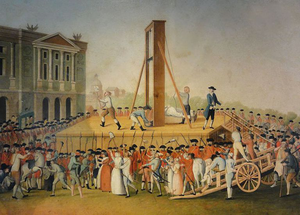Umbrella Revolution: Difference between revisions
No edit summary |
No edit summary |
||
| (One intermediate revision by the same user not shown) | |||
| Line 22: | Line 22: | ||
*{{flag|Umbrellya}}}} | *{{flag|Umbrellya}}}} | ||
*Clergy | *Clergy | ||
*House Frèmont | *House of Frèmont | ||
*House Barlliét | *House of Barlliét | ||
*House Soufrais | *House of Soufrais | ||
*House Côgnosènteur | *House of Côgnosènteur | ||
*Minor houses | *Minor houses | ||
*Highborn | *Highborn | ||
| Line 53: | Line 53: | ||
Following the execution of the king, the 4 major houses attempted to take control of the throne and end the civil unrest still predominately only taking place in the capital, Janjirie. House Barlliét and House Frèmont attempted a cooperative coop and later a royal union between the houses but ultimately faced too much difficulty attempting to enter the city by revolutionaries. By June, there were 3 separate claims to the throne with all claimants in exile from the throne. The then ruling royal family, House Côgnosènteur, fled to the [[Georgiet Islands]] in the Teal Bay, where they lived in exile for 60 years. | Following the execution of the king, the 4 major houses attempted to take control of the throne and end the civil unrest still predominately only taking place in the capital, Janjirie. House Barlliét and House Frèmont attempted a cooperative coop and later a royal union between the houses but ultimately faced too much difficulty attempting to enter the city by revolutionaries. By June, there were 3 separate claims to the throne with all claimants in exile from the throne. The then ruling royal family, House Côgnosènteur, fled to the [[Georgiet Islands]] in the Teal Bay, where they lived in exile for 60 years. | ||
==Civil Conflict== | |||
Beginning in September, the 5 kingdoms in the union experienced violent opposition to continuing dynastic rule. Large breakouts of revolutionary territory, known as ''"Freeland"'' to revolutionaries, began spreading across the kingdoms as a result of increased oppression of those seeking democratic reform. To limit risk to the rest of the royal houses, they formed an unofficial alliance against revolutionary forces. | |||
{{Sunalaya Topics}} | {{Sunalaya Topics}} | ||
Latest revision as of 20:41, 1 March 2020
This article is incomplete because it is pending further input from participants, or it is a work-in-progress by one author. Please comment on this article's talk page to share your input, comments and questions. Note: To contribute to this article, you may need to seek help from the author(s) of this page. |
The Umbrella Revolution and ensuing revolutionary war was a major conflict in Umbrellya during the 19th Century. Major causes for the revolution include the 1824 Southern Famine, existing tensions between the lower and royal classes, and the 1822 Sacking of Bûbaton - ending the Daffodil Rebellion. However, the cause behind sparking the revolution occurred with the executions of all members of the King's Council for their role in the Daffodil Rebellion.
Civil discourse began in April following the public execution of Gregore Admane, one of the members of the King's Council and highly suspected proponent of the values carried in the Daffodil Rebellion. All members of the council were executed over suspected involvement with Admane and his contacts. Janjirie's famous Abelettes Square became the epicentre of the revolution as members of the Royal Palace Guard were abducted from the Topaz Palace and executed. 2 months later, King Olivier VIII was kidnapped and executed as well.
Following the execution of the king, the 4 major houses attempted to take control of the throne and end the civil unrest still predominately only taking place in the capital, Janjirie. House Barlliét and House Frèmont attempted a cooperative coop and later a royal union between the houses but ultimately faced too much difficulty attempting to enter the city by revolutionaries. By June, there were 3 separate claims to the throne with all claimants in exile from the throne. The then ruling royal family, House Côgnosènteur, fled to the Georgiet Islands in the Teal Bay, where they lived in exile for 60 years.
Civil Conflict
Beginning in September, the 5 kingdoms in the union experienced violent opposition to continuing dynastic rule. Large breakouts of revolutionary territory, known as "Freeland" to revolutionaries, began spreading across the kingdoms as a result of increased oppression of those seeking democratic reform. To limit risk to the rest of the royal houses, they formed an unofficial alliance against revolutionary forces.
